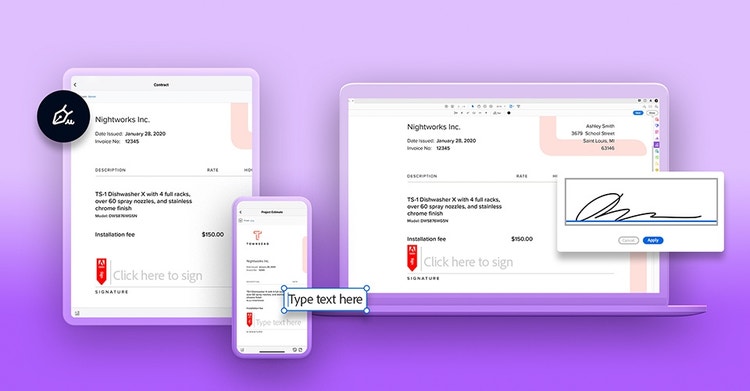Adobe Acrobat Sign
What is a non-disclosure agreement (NDA)?
Use NDAs to keep confidential information safe without slowing down your work.

What is a nondisclosure agreement (NDA)?
A nondisclosure agreement (NDA) is a legal document between two or more parties who agree not to disclose any sensitive information revealed over the course of doing business together. Like the privacy agreements that protect confidentiality between doctors and patients, and between attorneys and their clients, NDAs provide an important protection for business owners who share confidential information with future partners or investors, their employees, and contractors.
Legal contracts like confidentiality agreements are important for small businesses and startups, both in and out of the tech world. If you have a great idea or invent technology, new products, or proprietary formulas you want to sell, you probably need to share it with others in order to seek funding, start production, and bring your product to market. Your business plan itself and valuable customer lists might also need protection. With an NDA, you have a legal agreement that can help safeguard your leads and ideas while you raise money and hire employees or freelancers.

When to use an NDA.
Consider using an NDA any time you enter into a confidential business relationship, but especially before you do any of these things:
- Discuss the sale or licensing of your intellectual property, including any product or technology.
- Grant employees or contractors access to trade secrets or other proprietary information.
- Present an offer to potential investors, partners, or prospective buyers.
5 common types of NDAs.
Mutual.
The mutual NDA form is just that — a binding contract that goes two ways. Both parties agree to keep the information confidential.
Non-Mutual.
These agreements cover situations where only one party (the discloser) is sharing confidential information with another or several parties (the receivers). The receivers are legally required to keep the information secret.
Multilateral.
Multilateral NDA agreements cover three or more parties who share proprietary information. One or more parties may disclose sensitive information, and all of the receiving parties promise to protect it. When many parties are involved, these types of NDAs are more efficient than establishing multiple separate agreements.
Terminating.
These are NDAs that expire. After an agreed time period, the disclosing party releases the receiving party from the agreement. The agreement can be set to end on a specific date or when the business relationship ends.
Non-Terminating.
These confidential disclosure agreements never expire, and the receiving party is bound to keep the information secret for as long as the parties work together or until the information becomes publicly available.

What to include in an NDA.
A nondisclosure agreement can include quite a bit of information. It’s always a good idea to get legal advice before executing one, to be sure of the exact NDA meaning. These are some of the most common and important items to include in your NDA template:
- Definition of the sensitive or proprietary information. What type of information does the agreement cover? What are the reasons for the disclosure?
- Identification of the parties to the agreement. Who is the discloser, and who is the recipient?
- Specific clauses and distinctions. Must the recipient make their best effort to keep the information secret? Do they receive information only on a need-to-know basis? Is the information “no use,” meaning that the recipient has no right to use the information in any way other than directed in the agreement?
- Exclusions. What information doesn’t count as secret? Which information is considered public knowledge?
- Obligations of the recipient. What must the recipient do with the information they receive? What can’t they do?
- Time periods. Does the agreement last for a specific time period, or for the length of a project or business partnership?
- Other terms. Who pays any legal fees to law firms and attorneys? How will disputes be resolved? After a certain time period, can the recipient hire the discloser’s employees? (But note that non-disclosure agreements are different from non-compete agreements.)

Complete nondisclosure agreements fast with Adobe Acrobat Sign.
Create your NDAs as soon as you’ve decided to engage in a joint venture or other business relationship. The sooner the agreements are signed, the sooner you can move the business forward. With Acrobat Sign, you can send an agreement securely as a PDF in four quick steps. Then track its progress. Your future partners, investors, and employees can fill the forms and add their binding e-signatures from any device, and you can get right to work.
Quick questions about NDAs, answered here.
What is an MNDA agreement?
One of the most frequently used types of confidentiality agreements is the mutual nondisclosure agreement (MNDA). In a unilateral NDA, one party agrees not to disclose the confidential information belonging to the other party. In a mutual NDA, by contrast, both parties agree not to reveal each other’s confidential information. While the unilateral NDA is a one-way street, an MNDA creates a confidential relationship where information is equally protected between the partners.
Do NDAs expire?
Some confidentiality agreements, called Terminating NDAs, are set to expire after a certain time — a specified date, for example, or when a particular project or the business relationship ends. The disclosing party then releases the receiving party from the agreement. Non-Terminating NDAs, on the other hand, never expire. The receiving party is bound to keep the information secret for as long as the parties work together, or until the information becomes publicly available.
Where can I find an NDA template?
Free NDA templates are widely available from a variety of legal and e-document sources online. Once you have a template that meets your needs, and you’ve run it past your own legal advisers, it’s quick and easy to send it as a secure PDF with Adobe Acrobat Sign. Then you can track its progress as future partners, investors, employees, or contractors fill the forms and add their binding e-signatures.
